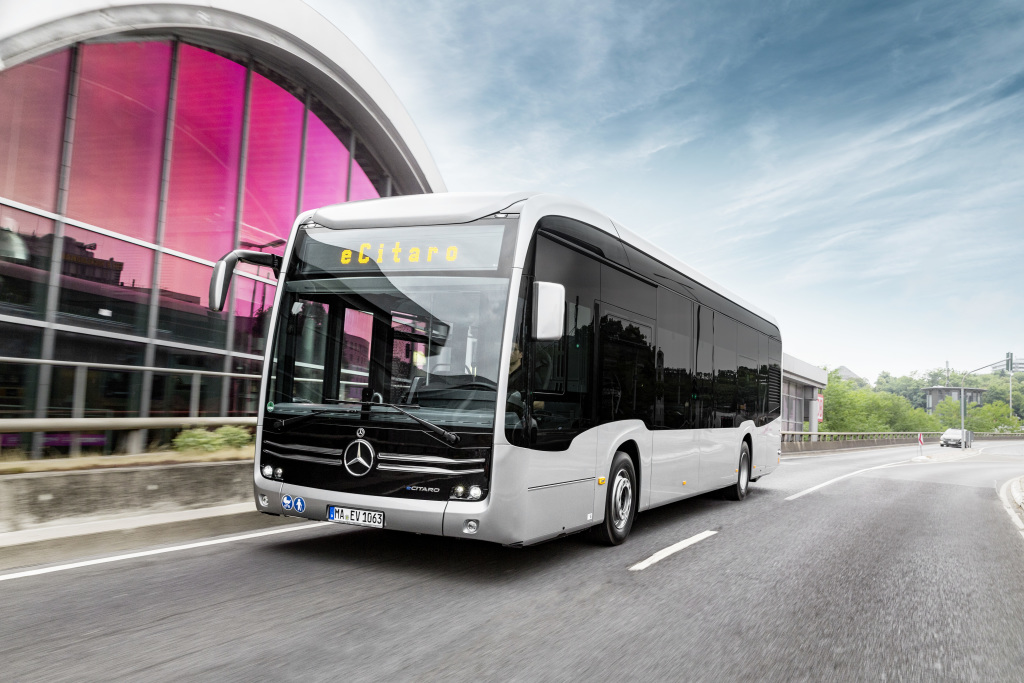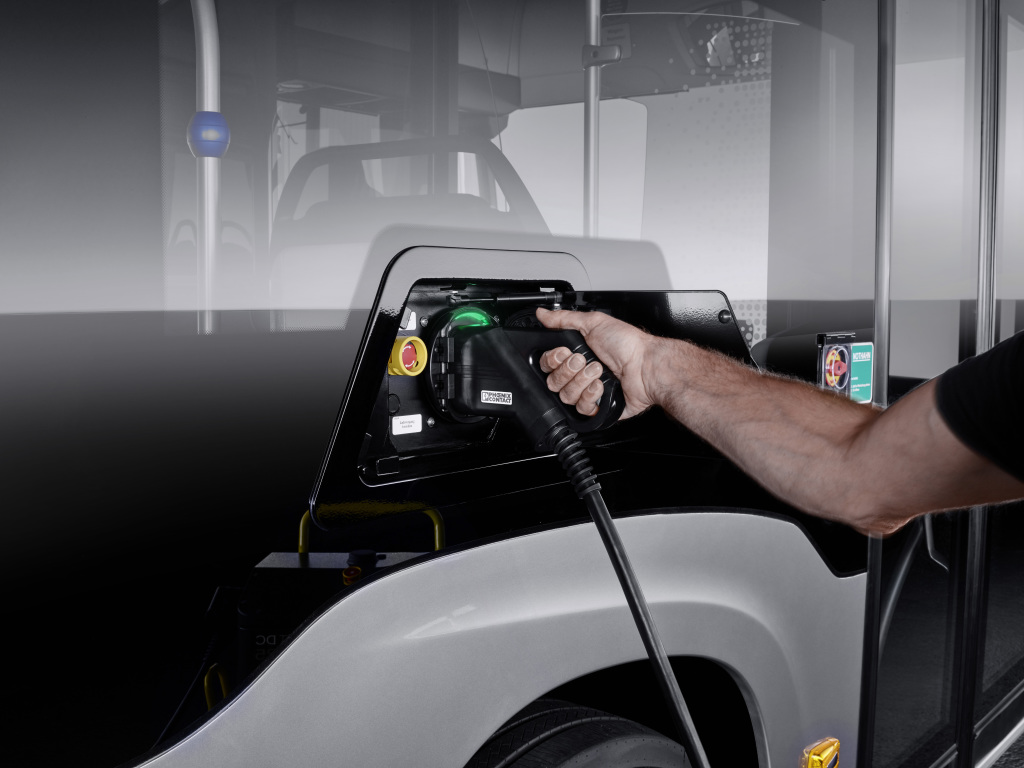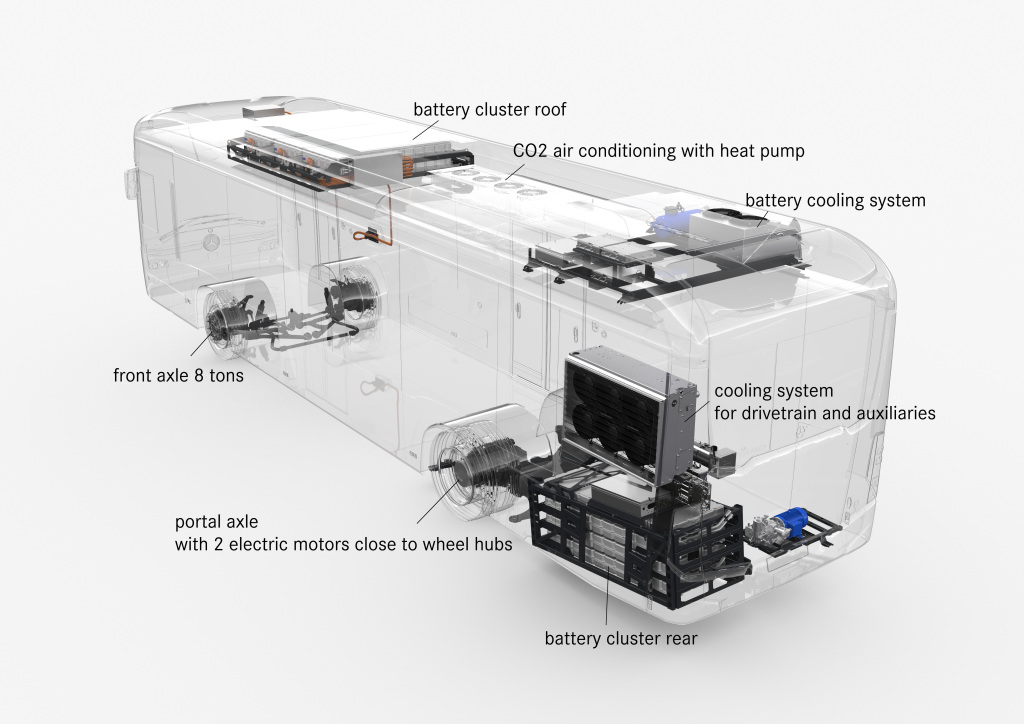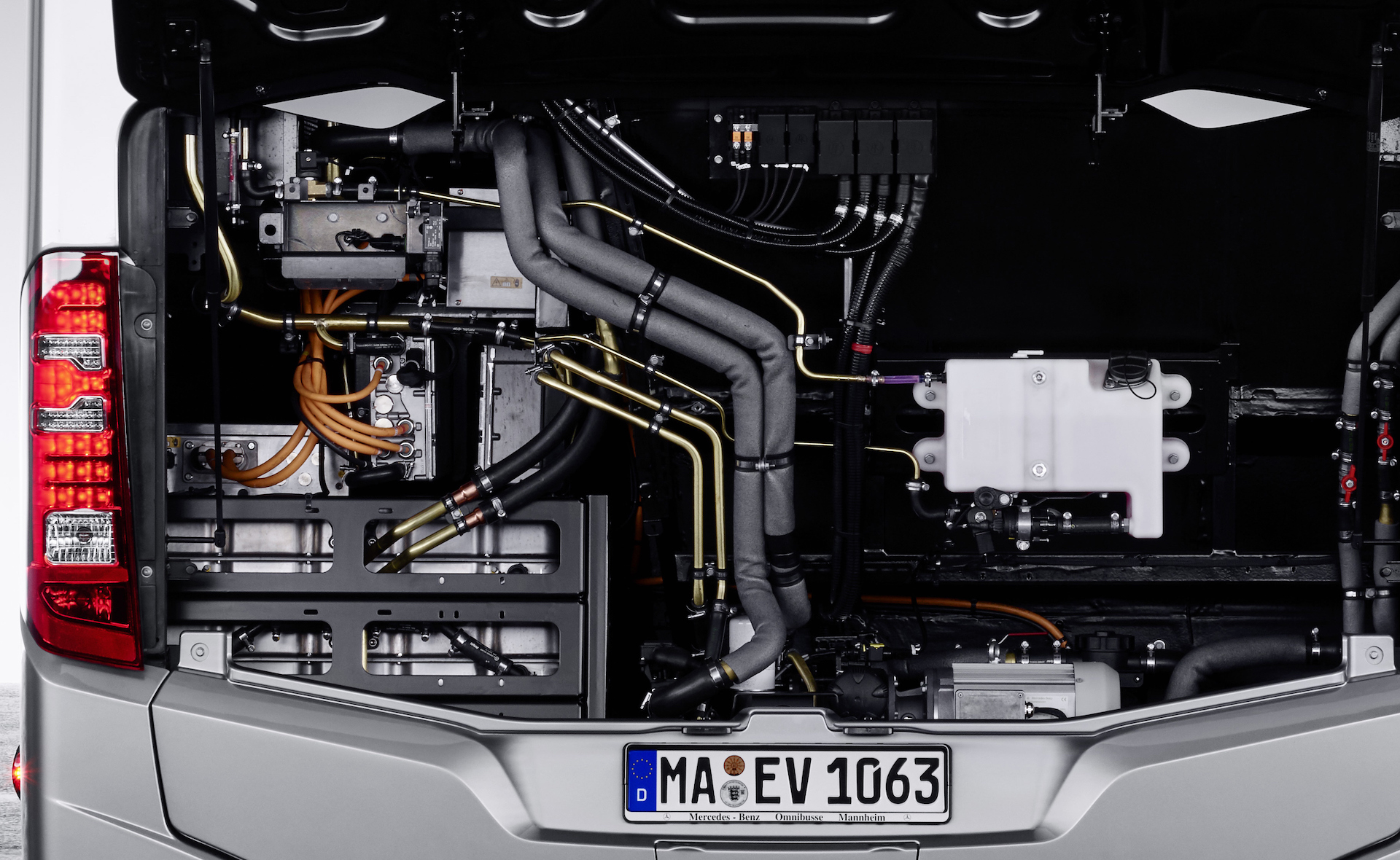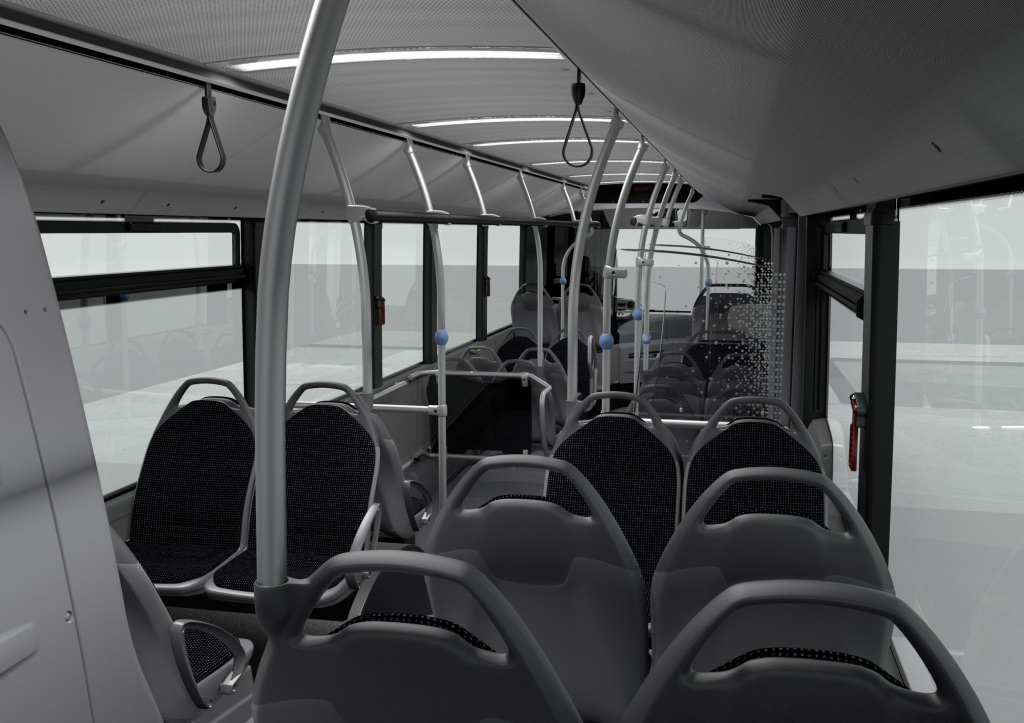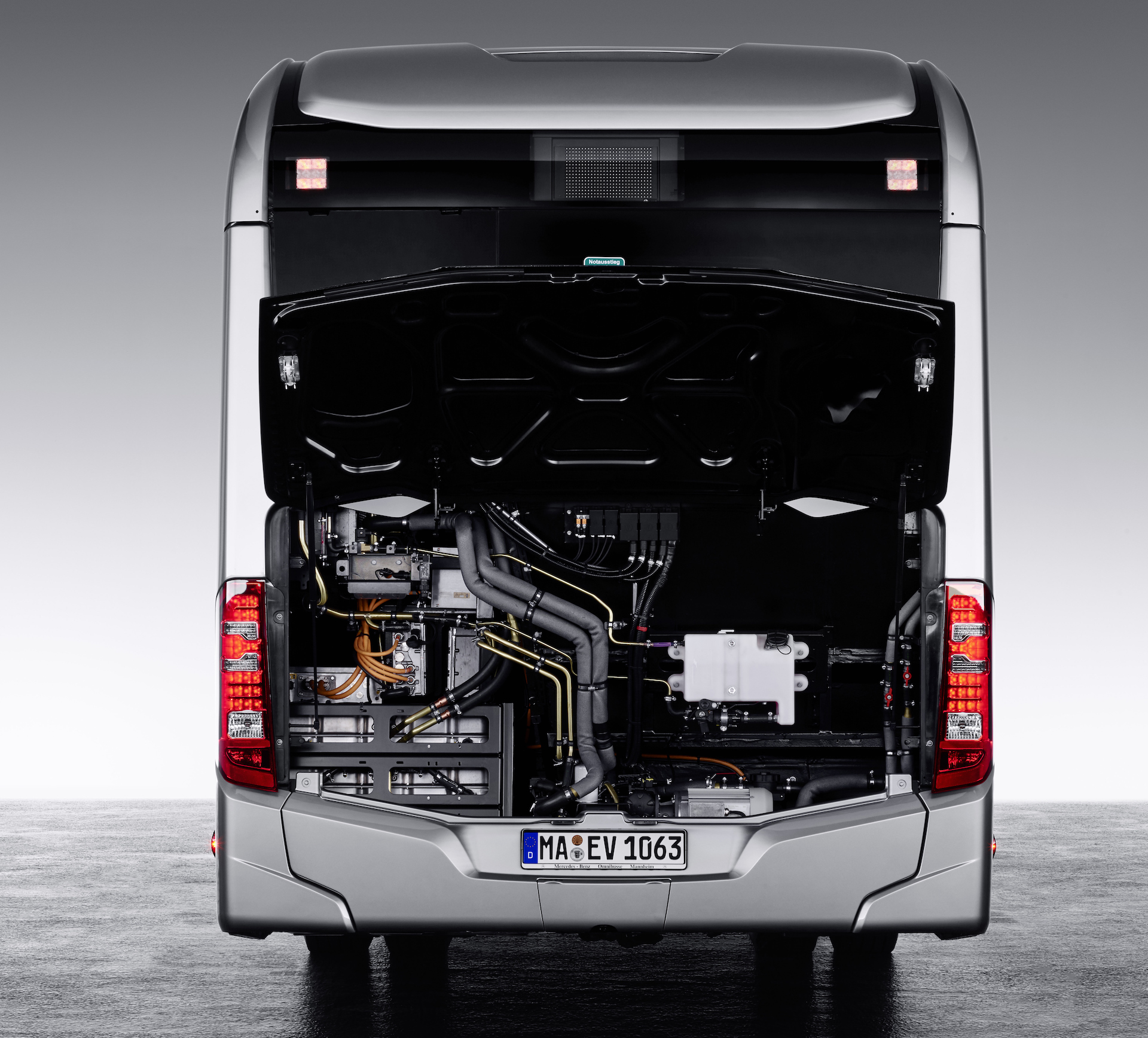It is locally emission-free and almost silent. It combines the tried and tested platform of the Mercedes-Benz urban bus with new technological solutions. The fully electric Mercedes-Benz eCitaro brings electromobility for urban buses to a whole new level. The new eCitaro uses innovative components now available for the first time for the eCitaro to achieve a previously unknown degree of energy efficiency. The performance of the eCitaro meets most of the requirements of the transport companies even at launch. Plus, it is already prepared for the battery technology of the future. And its design allows the basic shape of the Citaro to merge with elements of the Mercedes-Benz Future Bus into a distinct visual appearance of its own. It’s more than an urban bus: Mercedes-Benz takes a holistic approach to electromobility and integrates the eCitaro into the overall eMobility system.
The eCitaro: world premiere in 2018, already a success
The eCitaro impresses with its performance and comes at precisely the right time. Although it only celebrated its world premiere last autumn at the International Commercial Vehicle Show, it is already out and about on the roads of Hamburg, Berlin, Mannheim and Heidelberg. Mercedes-Benz recently received a major order for 56 eCitaro vehicles from Wiesbaden. It is the largest single order ever received in Germany for all-electric buses. Mercedes‑Benz is optimistic that further successes will follow soon. A fleet of demonstration buses which is currently showing the eCitaro’s qualities to transport companies on-location in Europe will play a part in this.
The tailor-made exclusive exterior of the eCitaro
The eCitaro benefits from the platform of the best-selling Citaro with more than 50,000 units sold all over the world. The eCitaro is a true Citaro – but a very special one; because its unique characteristics match its equally unique design.
This is already evident in the face of the eCitaro. Its centre-point is formed by the Mercedes star. Decorative elements emanate from the star, to the left and right. The model insignia with its blue letter “e” discreetly and yet unmistakably indicates the fully electric drive technology. The bumper and the model-specific three-dimensional A0 pillars neatly frame the face of the eCitaro. Another feature of the urban bus is the curve of its windscreen with the integrated destination display. Visually, the windscreen smoothly transitions into the roof with dark bars on the left and right.
The roof-mounted equipment on the eCitaro is concealed behind an elegant roof-edge ridge made of a multi-piece extruded aluminium section. The glossy black lower segment extends the generous side-window glazing of the urban bus. The upper segment is painted in the vehicle colour. These optical tricks lend the eCitaro perfect proportions.
A fusion of elegant and at the same time practical design
Overall, the eCitaro sports a solid appearance with clearly drawn contours and no showmanship whatsoever. At the same time, the new eCitaro is a truly practical bus. The eCitaro adopts the structure of the current model unchanged – a crucial factor in facilitating the repair of accident damage, for example. The curved windscreen comes from the Citaro Ü and is thus a common spare part. The roof-edge ridge at the sides is not only a two-part design, it is also segmented.
Interior: new coffered ceiling with high-tech lighting
In the passenger compartment, the eCitaro rings in a general update of the interior concerning the entire Citaro family. A stand-out feature in the interior is the coffered design ceiling above the centre aisle and the sweeping roof-edge flaps. They hide a new air circulation system with textile ducts in place of the current plastic air ducts. They are even easier and simpler to install.
The technology modules, as connectors between the individual elements of the coffered ceiling, are particularly noteworthy. They combine the interior lights and the loudspeakers in one element. In line with this step, the interior lights have also been switched over to LED technology as standard. The lighting is ingenious: the light of the LED lamps is refracted in a way to make the technology modules appear to the observer as one homogeneous light panel.
Another new feature is the black trim on the sills and window posts. As a result, the window posts stand out less, soothing the appearance of the side walls.
Proven electric axle, now up to twelve battery modules
The powertrain of the new eCitaro is based on the proven and optimised ZF AVE 130 electric portal axle with electric motors at the wheel hubs. The peak output of the motors is 2 x 125 kW, while torque is 2 x 485 Nm. It is an inherent feature of such motors that this is fully available right from the start, ensuring appropriate dynamic performance even with a full complement of passengers.
Lithium-ion batteries supply the power. New: their total capacity is as high as 292 kWh. Background information: The batteries are now split between as many as twelve modules, instead of the initial ten, each supplying around 25 kWh. The basic equipment sees two battery modules on the vehicle roof plus four fitted at the rear. Depending on customer requirements, up to six further battery modules are mounted on the roof of the eCitaro.
With the full complement of twelve batteries, the eCitaro as a two-door model with standard equipment weighs around 14.1 tonnes with a permissible gross vehicle weight of 19.5 tonnes. This corresponds to seats for around 80 passengers – very practicable during rush hour.
Flexible charging technology: Charging at the depot as standard, optional current collector
The eCitaro’s charging technology also allows it to adjust to the individual wishes and requirements of the transport operators. For the start of series production, plug-in charging is envisaged. To this end, the urban bus features a socket for a Combo 2 plug above the front wheel arch on the right-hand side of the vehicle in the direction of travel.
If intermediate charging is required to extend the range, there will in future also be an option to charge the eCitaro via a current collector on the roof. This option will be gradually phased in, once series production has started. There will be two possible variants: In phase 1, an integral current collector (pantograph) on the roof; in phase 2, charging rails on the roof that will allow charging via a stationary current collector at a charging station.
Thermal management: new methods for heating and air conditioning
However, the battery capacity alone provides little indication of the actual performance capability and, above all, the range of an all-electric urban bus – the true measure is that of energy consumption. In the case of an urban bus, this is impacted significantly by climatic conditions and the need to cool and, above all, to heat the interior.
At an outside temperature of minus ten degrees Celsius, the energy consumption of an urban bus doubles compared to journeys where no heating is required. Therefore the engineers have carefully considered the issue of thermal management. Compared with the current Citaro with a combustion engine, the energy requirement for heating, ventilation and climate control has been reduced by about 40 percent. This exceptional energy efficiency provides the basis for the eCitaro’s practical operating range even under unfavourable conditions. This is accomplished with the use of innovative components that only reached market readiness in line with the eCitaro.
Heating featuring heat pump, networking of components
In the first instance, Mercedes-Benz cools the batteries to ensure that they remain at the ideal temperature, thereby ensuring maximum charging capacity, performance capability, and service life. At extreme outside temperatures, the passenger-compartment climate control system is used to boost the cooling of the batteries.
The passenger compartment of the eCitaro is heated in an energy-efficient manner by a heat pump. Even temperature distribution is ensured by using the familiar sidewall fan heaters. The conventional heater at the front is equipped with a double heat exchanger.
All components that give off heat are linked together, to keep the amount of energy required for their cooling to a minimum. Since the human body also gives off heat, the heating on a bus carrying a full complement of passengers can be turned down earlier. Furthermore, Mercedes-Benz varies the output of the heating and climate control systems according to the number of passengers.
During the colder months, the roof-mounted air conditioning system is additionally used as a heat pump, ensuring effective and efficient climate control for the passenger compartment. The use of CO2 as a coolant brings further benefits. The particularly efficient use of the heat pump is impressive, even at very cold temperatures.
Another advantage: While the batteries are being charged in the depot, the vehicle interior can be pre-conditioned and even over-conditioned to the desired temperature. The bus will therefore have been heated or cooled to suit the seasonal conditions before it sets off.
Practical range even in tough conditions
Operating range figures for all-electric-powered urban buses are often difficult to compare. Mercedes-Benz prefers to consider a “worst-case scenario” and therefore takes its direction from the challenging standardised city driving cycle known as SORT 2 and includes the energy requirements of the auxiliary consumers in its calculations. According to this, the Citaro achieves an operating range of around 170 kilometres in summer. This means that even without intermediate charging, the eCitaro already covers about one third of all routes. Under ideal conditions, the eCitaro even drives around 280 km without intermediate charging.
Driver’s area: familiar cockpit with a power meter in place of a rev counter
Benefit for the eCitaro driver: cockpit and operating concept of the urban bus are largely unchanged – except that a power meter now replaces the rev counter. It displays the current power demand and/or energy recuperation rate. The driver also receives information about the charge status of the batteries. He or she can access the range, available power and a charging indicator on the central display.
In general, the performance is optimised for maximum efficiency, without the driver having to deal with major differences from the Citaro with combustion engine. For example, in the basic setting, the bus coasts in an energy-efficient manner when the driver takes her/ his foot off the accelerator pedal – it “glides”. Alternatively, the driver can use a multi-stage electric brake lever to set a basic deceleration rate – similar to the engine braking torque or the retarder effect of a diesel bus – as the energy recovery rate.
The future is electric: launch of an innovation initiative
As the development of battery technology is progressing at a rapid pace, the eCitaro is already designed to be transitioned to the battery technology of the future. This concerns for example the lithium-ion batteries currently in use. As things currently stand, the next generation with a larger capacity and resulting increased range will already be available for customers of the eCitaro in 2021. With a total capacity of up to 330 kWh, the eCitaro will then cover about 50 percent of all applications.
Another step already scheduled for the coming year envisages the optional use of future lithium-polymer batteries, also referred to as solid-state batteries. With this new battery technology, the eCitaro once again takes on a leading role, and is even among the pioneers in automotive construction. Solid state batteries are characterised by a particularly long service life and high energy density. With a nominal battery capacity of up to 441 kWh, the eCitaro would then be able to cover around 70 percent of all requirements without the need for intermediary charging. As a solobus, even when faced with the difficult demands of using all-electric heating in the winter months, the eCitaro can still cover more than 200 km in accordance with the SORT 2 testing method. The characteristics of solid-state batteries differ significantly from NMC batteries (lithium-nickel-manganese-cobalt-oxide cells): They have a different shape, are more voluminous overall and are not suitable for quick-charging. Urban buses equipped with them are therefore suitable for other types of application. For this reason, the eCitaro will in future be offered with a choice of NMC or solid‑state batteries.
Subsequently, the range of the eCitaro will be increased yet again by a range extender in the form of a fuel cell for generating electricity. It will be designed to allow the eCitaro to fulfil nearly 100 percent of all requirements on urban buses. This technology eliminates the need for intermediate charging and the complex infrastructure required for it in almost all cases: The eCitaro will be able to replace combustion engine-powered urban buses almost one to one.

